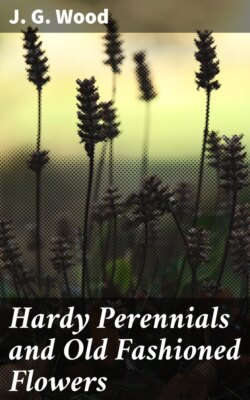Читать книгу Hardy Perennials and Old Fashioned Flowers - J. G. Wood - Страница 4
На сайте Литреса книга снята с продажи.
Acæna Novæ Zealandiæ.
ОглавлениеTable of Contents
Otherwise A. Microphylla; Nat. Ord. Sanguisorbeæ, or Rose Family.
The plant, as may be seen by the illustration (Fig. 1), is small, and its flowers are microscopic, hardly having the appearance of flowers, even when minutely examined, but when the bloom has faded there is a rapid growth, the calyces forming a stout set of long spines; these, springing from the globular head in considerable numbers, soon become pleasingly conspicuous, and this is by far the more ornamental stage of the plant. It is hardy, evergreen, and creeping. It seldom rises more than one or two inches from the ground, and only when it approaches a wall, stones, or some such fixed body, does it show an inclination to climb; it is, therefore, a capital rock plant. As implied by its specific name, it comes from New Zealand, and has not long been acclimatised in this country.
The flowers are produced on fine wiry stems an inch or more long, being nearly erect; they are arranged in round heads, at first about the size of a small pea; these, when bruised, have an ammoniacal smell. Each minute flower has four green petals and brownish seed organs, which cause the knob of flowers to have a rather grimy look, and a calyx which is very hard and stout, having two scales and four sepals. These sepals are the parts which, after the seed organs have performed their functions, become elongated and of a fine rosy-crimson colour; they form stiff and rather stout spines, often ¾in. long; they bristle evenly from every part of the little globe of seed vessels, and are very pretty. The spines are produced in great abundance, and they may be cut freely; their effect is unique when used for table decoration, stuck in tufts of dark green selaginella. On the plant they keep in good form for two months. The leaves are 1in. to 2in. long, pinnate; the leaflets are of a dark bronzy colour on the upper side and a pale green underneath, like maidenhair, which they also resemble in form, being nearly round and toothed. They are in pairs, with a terminal odd one; they are largest at the extremity, and gradually lessen to rudimentary leaflets; the foliage is but sparingly produced on the creeping stems, which root as they creep on the surface.
Fig. 1. Acæna Novæ Zealandiæ. (One half natural size.)
The habit of the plant is compact and cushion-like, and the brilliant spiny balls are well set off on the bed of fern-like but sombre foliage. During August it is one of the most effective plants in the rock garden, where I find it to do well in either moist or dry situations; it grows fast, and, being evergreen, it is one of the more useful creepers for all-the-year-round effect; for covering dormant bulbs or bare places it is at once efficient and beautiful. It requires light soil, and seems to enjoy grit; nowhere does it appear in better health or more at home than when carpeting the walk or track of the rock garden.
It is self-propagating, but when it is desirable to move a tuft of it, it should be done during the growing season, so that it may begin to root at once and get established, otherwise the wind and frosts will displace it.
It blooms from June to September, more or less, but only the earliest flowers produce well-coloured spines.
